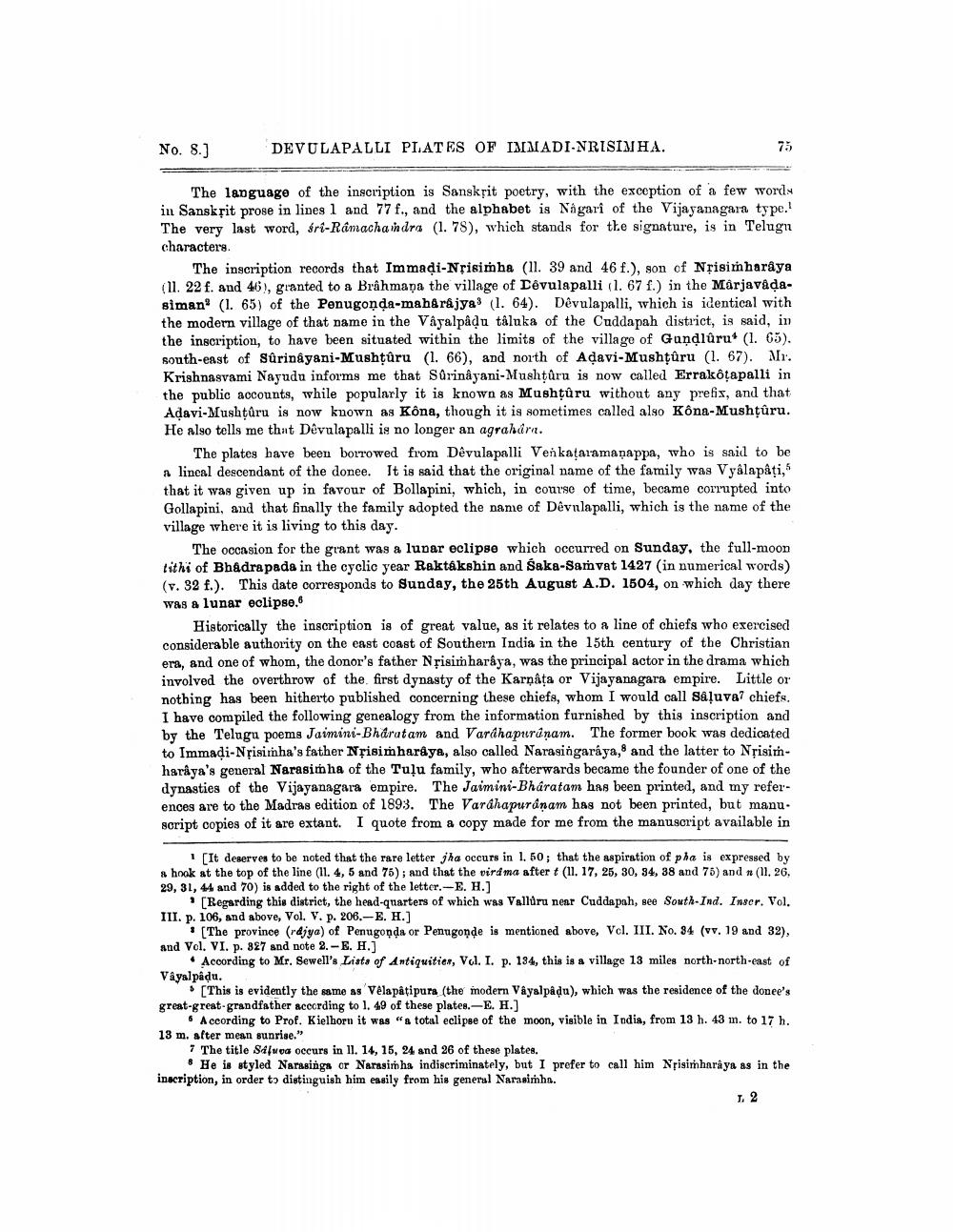________________
No. 8.)
DEVULAPALLI PLATES OF IMMADI.NRISIMHA.
The language of the inscription is Sanskpit poetry, with the exception of a few words in Sanskrit prose in lines 1 and 77 f., and the alphabet is Nagari of the Vijayanagara type.! The very last word, Sri Ramachandra (1. 78), which stands for the signature, is in Telugn characters.
The inscription records that Immadi-Nrisimha (11. 39 and 46 f.), son of Nrisim haraya (1l. 22 f. and 46), granted to a Brahmana the village of Devulapalli (1. 67 f.) in the Marjavadasiman (1. 65) of the Penugonda-mahrajya: (1. 64). Devulapalli, which is identical with the modern village of that name in the Vayalpadu tâluka of the Cuddapah district, is said, in the inscription, to have been situated within the limits of the village of Gundluru* (1. 65). south-east of Surinayani-Mushtûru (1. 66), and north of Adavi-Mushţuru (1. 67). Mr. Krishnasvami Nayudu informs me that Surinåyani-Mushtûru is now called Errakotapalli in the public accounts, while popularly it is known as Mushţůru without any prefis, and that Adavi-Mushţuru is now known as Kôna, though it is sometimes called also KÔna-Mushtûru. He also tells me that Devulapalli is no longer an agrahar.
The plates have been borrowed from Devulapalli Venkataramapappa, who is said to be a lineal descendant of the donee. It is said that the original name of the family was Vyålapåți, that it was given up in favour of Bollapini, which, in course of time, became corrupted into Gollapini, and that finally the family adopted the name of Devulapalli, which is the name of the village where it is living to this day.
The occasion for the grant was a lunar eclipse which occurred on Sunday, the full-moon dithi of Bhadrapada in the cyclio year Raktákshin and Saka-Samvat 1427 (in numerical words) (v. 32 f.). This date corresponds to Sunday, the 25th August A.D. 1504, on which day there Was a lunar eclipse.
Historically the inscription is of great value, as it relates to a line of chiefs who exercised considerable authority on the east coast of Southern India in the 15th century of the Christian era, and one of whom, the donor's father Nrisimharaya, was the principal actor in the drama which involved the overthrow of the first dynasty of the Karnața or Vijayanagara empire. Little or nothing has been hitherto published concerning these chiefs, whom I would call såļuva chiefs. I have compiled the following genealogy from the information furnished by this inscription and by the Telugu poems Jaimini-Bharatam and Vardhapuranam. The former book was dedicated to Immadi-Nộisimha's father Nộisimharaya, also called Narasingaráya, and the latter to Nrisimharầya's general Narasimha of the Tuļu family, who afterwards became the founder of one of the dynasties of the Vijayanagara empire. The Jaimini-Bharatam has been printed, and my references are to the Madras edition of 1893. The Vardhapuranam has not been printed, but manu. script copies of it are extant. I quote from a copy made for me from the manuscript available in
1 [It deserves to be noted that the rare letter jha occurs in 1. 50; that the aspiration of pha is expressed by #hook at the top of the line (11. 4, 5 and 75); and that the virama after + (11, 17, 25, 30, 34, 38 and 76) and * (11. 26, 29, 31, 44 and 70) is added to the right of the letter.-E. H.]
Regarding this district, the head-quarters of which was Valldru near Cuddapah, see South Ind. Inser. Vol. III. p. 106, and above, Vol. V. p. 206.-E. H.)
! (The province (rdjya) of Penugonda or Penugonde is mentioned above, Vol. III. No. 84 (vv. 19 and 32), and Vol. VI. p. 827 and note 2.-E. H.]
• According to Mr. Sewell's Lista of Antiquitier, Vol. I. p. 134, this is a village 13 miles north-north-east of Vayalpadu.
> [This is evidently the same as Vėlapâțipura (the modern Vayalpadu), which was the residence of the donee's great-great-grandfather acccrding to 1. 49 of these plates.-E. H.]
According to Prof. Kielborn it was a total eclipse of the moon, visible in India, from 13 h. 43 in. to 17 h. 13 m. after mean sunrise."
7 The title Salvoa occurs in 11. 14, 15, 24 and 26 of these plates.
He is styled Narasings or Narasimha indiscriminately, but I prefer to call him Nrisimharaya as in the inscription, in order to distinguish him easily from his general Narasimhn.
I 2




